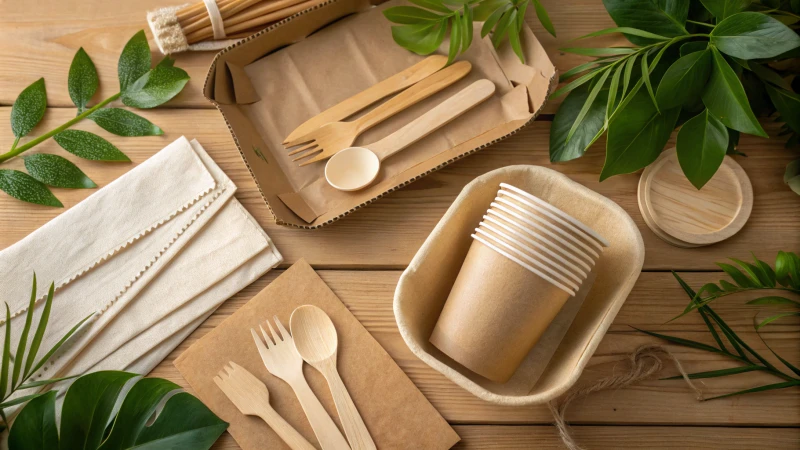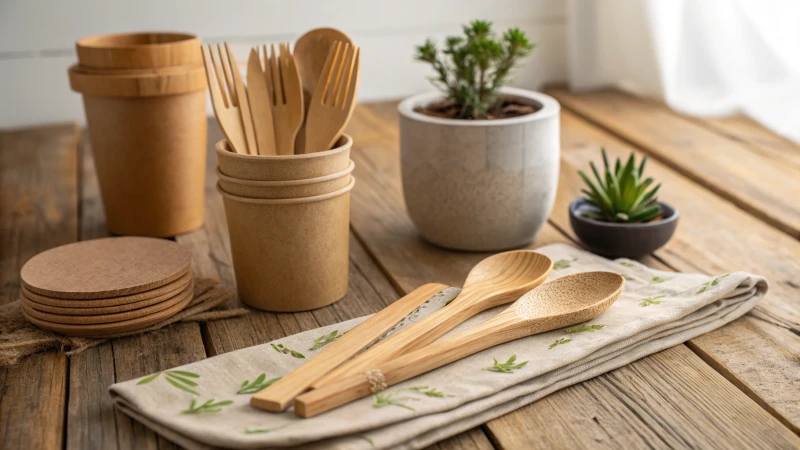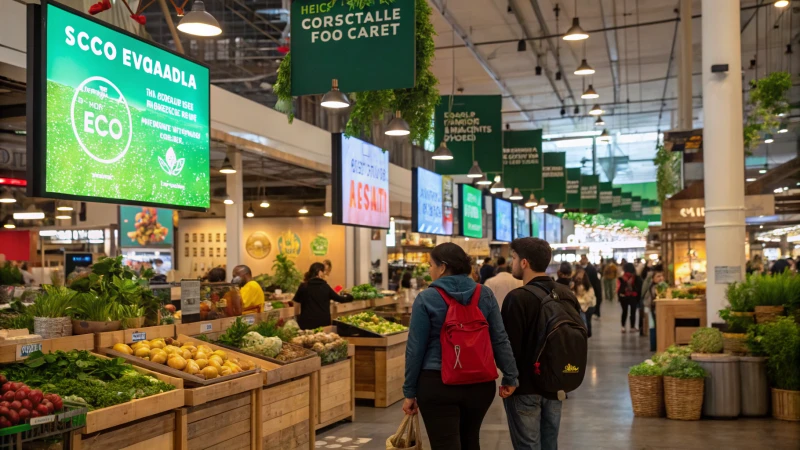
Remember the last time you swapped plastic forks for wooden ones at a picnic? That's the charm of disposable wooden cutlery—eco-friendly, stylish, and sustainable.
To effectively market disposable wooden cutlery, focus on sustainability, utilize social media, form strategic partnerships, and engage in targeted online advertising. These strategies enhance visibility, attract eco-conscious consumers, and emphasize the advantages over traditional plastic cutlery.
When I first ventured into promoting eco-friendly products, I discovered that aligning with consumer values was key. It's not just about selling a product; it's about telling a story that resonates with people's desire to make environmentally sound choices. For instance, highlighting the sustainability of wooden cutlery not only satisfies a practical need but also taps into an emotional appeal—an appeal to those who want to contribute to a greener planet.
Exploring platforms like Instagram or TikTok can open new doors to creatively engage with audiences. I've seen firsthand how these platforms can transform a simple product launch into a viral moment. Through strategic partnerships with influencers or eco-conscious brands, I have learned to amplify our message and reach audiences who are already on the lookout for sustainable options. It's all about creating a community around your product and values.
Moreover, targeted online advertising allows us to reach those who might not yet realize the impact of their everyday choices. By showcasing the unique benefits of wooden cutlery, such as its biodegradability and aesthetic appeal, we can gently steer consumers away from plastic alternatives.
Through these marketing strategies, I've seen how disposable wooden cutlery can transcend being just another product and become part of a lifestyle choice, one that aligns perfectly with modern demands for sustainability and style.
Emphasizing sustainability boosts wooden cutlery sales.True
Sustainability appeals to eco-conscious consumers, enhancing product appeal.
Social media is ineffective for marketing wooden cutlery.False
Social media increases visibility and engagement with target audiences.
How Can Sustainability Drive Consumer Interest in Wooden Cutlery?
Ever wondered how choosing wooden cutlery over plastic can make a real difference?
Sustainability boosts consumer interest in wooden cutlery by matching eco-friendly values, cutting down plastic waste, and adding a natural touch to dining. This makes it the go-to choice for green-minded individuals and businesses.

Aligning with Eco-Friendly Values
I’ve always been driven by values that make me feel part of something bigger—like protecting our planet. Choosing wooden cutlery feels like a small, personal commitment to sustainability. These utensils are not only biodegradable but also crafted from renewable resources1. Businesses that tap into this growing trend can truly stand out. When I see a company highlighting the lifecycle of their products—from responsibly sourced wood to its natural return to earth—I’m more inclined to support them.
Reducing Plastic Waste
I remember the day I realized just how much plastic waste I contributed through everyday choices. It was eye-opening. Shifting to wooden cutlery has been one way I’ve tried to make a change. By opting for wood over plastic, I'm not just reducing waste but actively participating in a global effort to lessen our environmental impact. A study2 I read once drove home how significant this swap can be, drastically cutting pollution levels.
Aesthetic Appeal and Versatility
There’s something charming about the rustic elegance of wooden utensils. They remind me of family picnics and upscale dining alike. Whether I’m at a chic restaurant or enjoying a backyard barbecue, wooden cutlery adds a touch of authenticity that plastic simply can’t match. Plus, businesses can customize these utensils to reflect their unique brand—transforming them into bespoke items that speak to customers seeking both uniqueness and quality3.
| Feature | Plastic Cutlery | Wooden Cutlery |
|---|---|---|
| Material | Petroleum-based | Renewable wood |
| Decomposition | Hundreds of years | Few months |
| Environmental Impact | High | Low |
| Aesthetic | Standard | Rustic/Unique |
Driving Demand Through Sustainable Marketing
I’ve seen firsthand how powerful sustainable marketing can be. By emphasizing sustainability credentials—like certifications for responsibly sourced materials—businesses not only capture my attention but earn my trust as an eco-minded consumer4. Storytelling that takes me on the product’s journey from production to disposal creates an emotional connection that’s hard to break. This approach doesn’t just drive interest; it builds loyalty.
Wooden cutlery is biodegradable and eco-friendly.True
Wooden cutlery decomposes in a few months, unlike plastic.
Plastic cutlery is more aesthetically appealing than wooden.False
Wooden cutlery offers a rustic, unique aesthetic over plastic.
How Does Social Media Impact the Marketing of Wooden Cutlery?
Imagine scrolling through your social media feed and stumbling upon a stunning image of beautifully crafted wooden cutlery, artfully arranged against a lush, green backdrop. Intrigued? That's the power of social media in action.
Social media plays a vital role in marketing wooden cutlery by enhancing brand visibility, connecting with eco-conscious consumers, and using storytelling and visuals to showcase product benefits and sustainability.

Understanding the Social Media Landscape
When I first dipped my toes into the world of social media marketing for our wooden cutlery, I was struck by how different platforms offered unique ways to connect with people. For example, Instagram's vibrant visuals made it perfect for showcasing the elegance of our products, while Pinterest allowed me to tap into trends and inspire eco-friendly living ideas.
| Platform | Key Features |
|---|---|
| Visual storytelling, influencer reach | |
| Visual discovery, trend spotting | |
| Community engagement, ads targeting |
Each platform has its own personality, and understanding these nuances helps in crafting a tailored content strategy.
Crafting Engaging Content
I remember the first time I shared a behind-the-scenes video of our artisans at work. The response was overwhelming! People loved seeing the craftsmanship that goes into every piece of cutlery. High-quality images and videos are essential. They should not only highlight the environmental benefits but also tell a story. This transparency builds trust and invites consumers into our world.
To capture the essence of your brand, consider developing short stories or behind-the-scenes looks at the manufacturing process. This not only promotes transparency but also builds trust with your audience.
Influencer Partnerships
Partnering with influencers5 who are genuinely passionate about sustainability has been a game-changer. Their authentic voices amplify our message, making it resonate with audiences who trust them. It's about finding those who align with our values and letting them tell our story in their own words.
Engaging Eco-Conscious Audiences
Nowadays, people are more discerning about their purchases. I’ve found that sharing stories about our sustainable practices and certifications opens up conversations. Encouraging followers to share their own experiences with our products not only builds community but also provides valuable feedback.
Consumers today are more informed and selective about their purchases. To engage eco-conscious audiences, highlight certifications and sustainable practices in your social media content.
Analyzing Social Media Metrics
Regularly checking metrics like likes, shares, and comments is like having a conversation with our audience. Tools like Google Analytics6 help me understand what content strikes a chord and where we can improve. By listening to these insights, we can continuously refine our strategies and stay true to our mission.
Instagram is ideal for showcasing wooden cutlery.True
Instagram's visual storytelling suits the aesthetic appeal of wooden cutlery.
Influencers have no impact on marketing wooden cutlery.False
Influencers can amplify brand messages and reach eco-conscious audiences.
How Can Strategic Partnerships Boost Your Brand's Visibility?
Have you ever wondered how teaming up with the right partner could skyrocket your brand's visibility?
Strategic partnerships enhance brand visibility by tapping into shared audiences, pooling resources for joint marketing efforts, and exploring new distribution channels. These collaborations often lead to a boost in brand awareness and market presence.

Leveraging Shared Audiences
I remember when I first partnered with an eco-friendly event planner. It felt like unlocking a door to a room full of potential customers I never knew existed. These partnerships allow brands like mine to dive into the audiences7 of their partners. Imagine a sustainable cutlery brand teaming up with an eco-conscious event planner to showcase products at prestigious events. It's a win-win where both brands gain exposure to each other's fan base.
Joint Marketing Initiatives
Once, we collaborated on a joint marketing campaign that combined our strengths in such a way that our brand message resonated louder than ever. Think of co-branded content or shared social media promotions—they're like amplifiers for our voices. For instance, if a restaurant chain partners with a local supplier to create a special menu8, both gain traction as they highlight each other's offerings.
Accessing New Distribution Channels
Every time we secure a new partnership, it's like opening a new doorway to potential customers. Forming alliances with distributors has allowed us to see our products in more places than we ever imagined. For a company like WonBon, expanding through these channels increases not just visibility but also credibility.
| Strategy | Benefits |
|---|---|
| Leveraging Shared Audiences | Access to new customer bases |
| Joint Marketing Initiatives | Amplified impact of promotional efforts |
| New Distribution Channels | Expanded reach and enhanced brand credibility |
Increased Brand Credibility
I can tell you that partnering with respected organizations has done wonders for our credibility. When customers see us collaborating with well-known entities, they tend to trust us more. It's akin to receiving endorsements from industry leaders9, which significantly boosts consumer confidence.
Innovation Through Collaboration
There's something magical about the innovation that sprouts from strategic partnerships. Bringing together diverse expertise often leads to fresh ideas and distinctive products. Picture a tech company joining forces with a food service provider to create an app for eco-friendly dining—it sets them apart from competitors.
Overall, strategic partnerships open up a world of opportunities for enhancing brand visibility through shared audiences, collaborative marketing, and expanded distribution while simultaneously boosting credibility and fostering innovation.
Strategic partnerships enhance brand credibility.True
Partnering with reputable organizations boosts a brand's trustworthiness.
Joint marketing initiatives reduce brand visibility.False
Collaborative marketing efforts amplify the impact of brand messaging.
Why is Targeted Advertising Crucial for Reaching Eco-Conscious Consumers?
Ever feel like the eco-conscious crowd is a tough nut to crack? Trust me, I've been there too!
Targeted advertising is essential for reaching eco-conscious consumers because it aligns a brand's messages with their sustainability values. By using data to create personalized ads, businesses can increase engagement and build lasting customer loyalty.

Understanding Eco-Conscious Consumers
Imagine trying to choose between two brands, but only one makes it clear they're using eco-friendly packaging. For those of us who care deeply about sustainability, this decision is a no-brainer. Eco-conscious consumers, like myself, often gravitate towards products and companies that reflect our values, especially when they minimize harm to our planet.
The Role of Data in Targeted Advertising
I remember my first attempt at reaching the eco-friendly audience. It was like throwing spaghetti at the wall to see what sticks! But then I discovered the power of data. By analyzing consumer behaviors and preferences, I could tailor my marketing efforts specifically to eco-conscious individuals. Suddenly, my messages weren't just going out into the void—they were landing exactly where they needed to be, increasing engagement and conversion rates dramatically.
Crafting Relevant Messages
Have you ever read an ad and thought, "Wow, they really get me"? That's the magic of well-crafted messaging. When we highlight our sustainable practices—like using recyclable materials or achieving carbon-neutral production—it resonates with eco-conscious consumers on a personal level. These messages are the bridge connecting our brand to those who value authenticity and transparency.
| Key Message Elements | Description |
|---|---|
| Sustainability | Highlight eco-friendly practices |
| Impact | Showcase positive environmental outcomes |
| Authenticity | Ensure transparency in claims |
Utilizing Social Media Platforms
When I first dipped my toes into social media marketing, platforms like Instagram and Facebook felt overwhelming. But once I started using their targeting tools, it was like having a secret weapon for reaching users interested in sustainable living10. Not only did my ad spend become more efficient, but I also connected with potential customers who truly cared about sustainability.
Measuring Success Through Analytics
I've learned that analytics are my best friend when it comes to understanding how eco-conscious audiences engage with ads. By tracking metrics like click-through rates and conversion, I've been able to refine my strategies and better align them with consumer expectations. Exploring successful case studies has shown me how targeted advertising can effectively reach eco-conscious consumers—and it can do the same for you!
Eco-conscious consumers prefer brands with sustainable practices.True
Eco-conscious consumers prioritize sustainability and choose brands that align with their values.
Social media is ineffective for targeting eco-conscious consumers.False
Platforms like Instagram and Facebook allow precise targeting of eco-conscious users.
Conclusion
Effective marketing strategies for disposable wooden cutlery include emphasizing sustainability, leveraging social media, forming partnerships, and utilizing targeted advertising to attract eco-conscious consumers.
-
Discover the types of renewable resources used in crafting wooden cutlery and their environmental benefits. ↩
-
Learn about studies comparing the environmental impact of plastic versus wooden utensils. ↩
-
Find inspiration for unique and personalized designs in wooden cutlery that enhance brand identity. ↩
-
Understand current trends in consumer behavior towards eco-friendly products and how it influences purchasing decisions. ↩
-
Discovering influencers who align with eco-friendly values can help amplify your brand message authentically. ↩
-
Using Google Analytics can help you track social media performance and tailor strategies to better meet audience needs. ↩
-
Learn how strategic collaborations allow brands to connect with previously untapped customer groups. ↩
-
Explore real-world examples of successful co-branded campaigns that increased brand recognition. ↩
-
Discover the role of endorsements in enhancing brand credibility and consumer trust. ↩
-
Learn about impactful social media strategies for engaging audiences interested in sustainable living, optimizing ad reach and engagement. ↩

